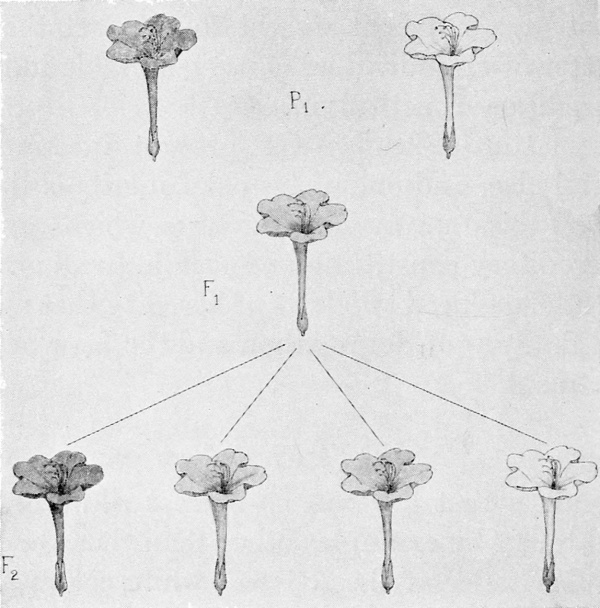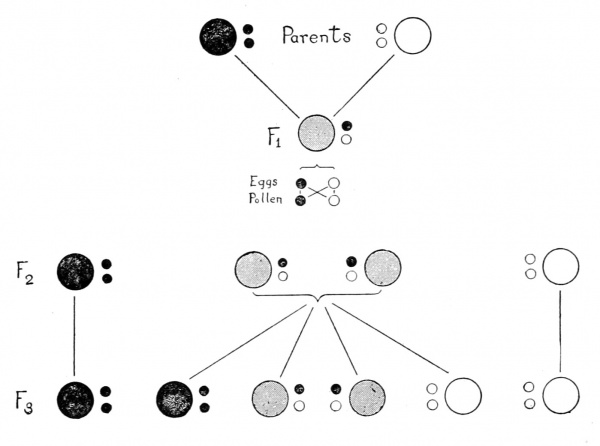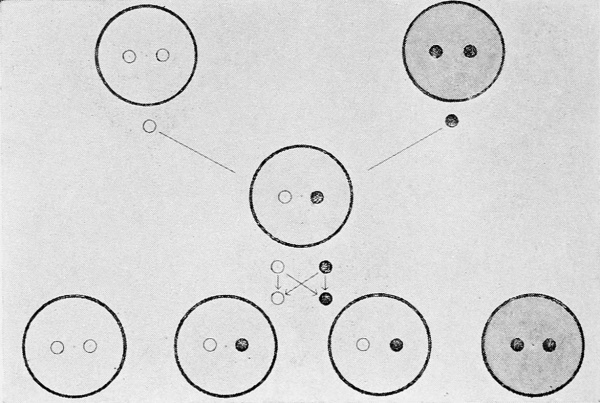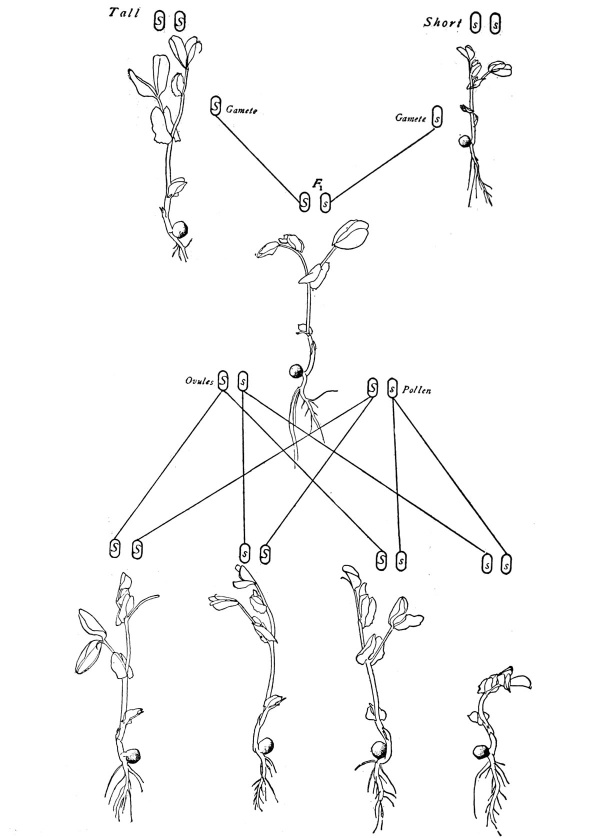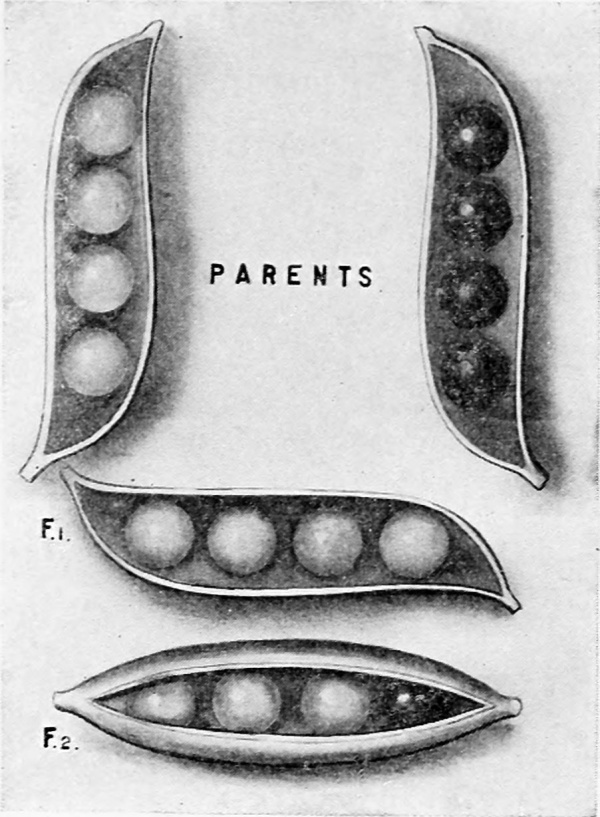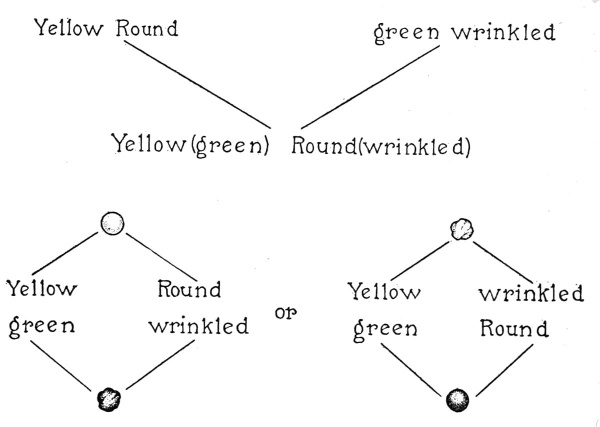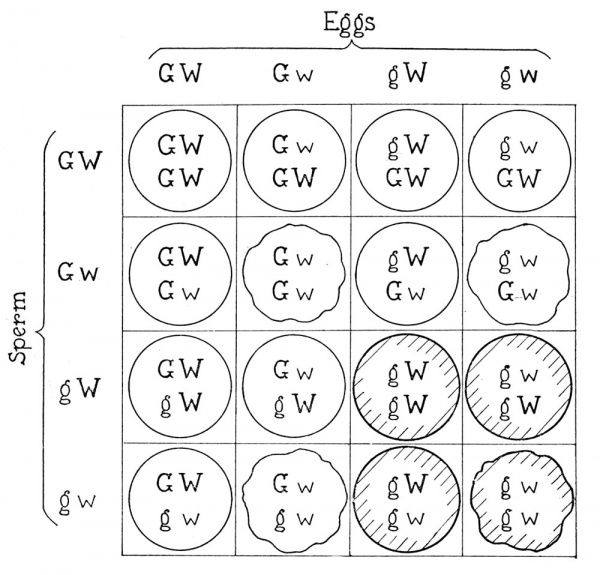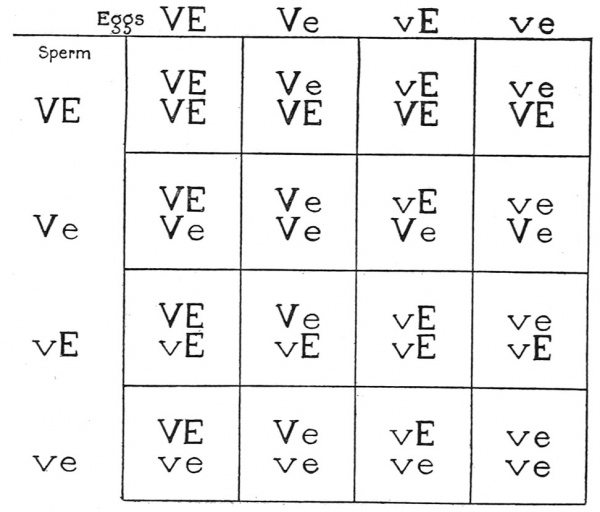Book - Evolution and Genetics 5
| Embryology - 27 Apr 2024 |
|---|
| Google Translate - select your language from the list shown below (this will open a new external page) |
|
العربية | català | 中文 | 中國傳統的 | français | Deutsche | עִברִית | हिंदी | bahasa Indonesia | italiano | 日本語 | 한국어 | မြန်မာ | Pilipino | Polskie | português | ਪੰਜਾਬੀ ਦੇ | Română | русский | Español | Swahili | Svensk | ไทย | Türkçe | اردو | ייִדיש | Tiếng Việt These external translations are automated and may not be accurate. (More? About Translations) |
Morgan TH. Evolution and Genetics (1925). Princeton University Press.
| Historic Disclaimer - information about historic embryology pages |
|---|
| Pages where the terms "Historic" (textbooks, papers, people, recommendations) appear on this site, and sections within pages where this disclaimer appears, indicate that the content and scientific understanding are specific to the time of publication. This means that while some scientific descriptions are still accurate, the terminology and interpretation of the developmental mechanisms reflect the understanding at the time of original publication and those of the preceding periods, these terms, interpretations and recommendations may not reflect our current scientific understanding. (More? Embryology History | Historic Embryology Papers) |
Chapter 5 Mendel's Two Laws of Heredity
Gregor Mendel studied the heredity of certain characters of the common edible pea, in the garden of the monastery at Brunn. In the account of his work published in 1865, he said:
- It requires indeed some courage to undertake a labor of such a far-reaching extent ; it appears, however, to be the only right way by which we can finally reach the solution of a question the importance of which cannot be over-estimated in connection with the history of the evolution of organic forms.
He tells us also why he selected peas for his work :
- The selection of the plant group which shall serve for experiments of this kind must be made with all possible care if it be desired to avoid from the outset every risk of questionable results.
The experimental plants must necessarily
- Possess constant differentiating characters.
- The hybrids of such plants must, during the flowering period, be protected from the influence of all foreign pollen, or be easily capable qf such protection.
Mendel succeeded not only because of his foresight in planning the experiments, and in keeping an exact record of the numbers of individuals of different kinds that appeared in the second and third generations, but also because of his insight in interpreting the results that he obtained.
Others had made crosses before Mendel. In fact, a great deal of work had been done in making crosses between wild species and also between cultivated varieties. We realize today that the earlier crosses between species failed to reveal the laws of heredity because so many characters were involved that the relationship of contrasted characters was obscured, and that the crosses between domesticated varieties failed either because the materials were not well chosen, or else because the numerical relations in the second generation were not observed. Some of the earlier hybridologists, who worked before Mendel's time and at about the same period, had observed that the parental types may reappear in the second and later generations. Naudin (1863, 1868) had even suggested that this reappearance is due to the separation of the parental types in the hybrid but he failed to detect the numerical relations involved and he did not make out the independent inheritance of the members of different pairs of characters.
About twenty years after Mendel's results were first announced, but before his results became generally known, Galton (1889-) formulated several laws of inheritance based in part on data from plants and animals, and also from man. He studied the problem from a statistical standpoint, as Mendel had done, but in the material that Galton used, the effects due to the environment were not separable from those due to inherited factors. Moreover he did not give sufficient weight to the fact that the character of an individual is not a suitable index of its hereditary constitution.
The latter difficulty was present in Mendel's material also, and one of his chief merits is that he detected this fact by making tests which revealed the hereditary constitution of each individual.
Mendel deduced two laws of heredity that may be called the Law of Segregation and the Law of Free Assortment.
Menders First Law
Mendel's first law can be more strikingly illustrated today by examples other than those he gave. The inheritance of the red and white colors of the flowers of the common garden plant Mirabilis jalapa or four o'clock furnishes an excellent example. If the pollen from a plant with white flowers is placed on the pistil of a plant with red flowers, the seeds that are produced give rise to a plant with pink flowers (fig. 17). The hybrid may be said to be intermediate in the color of its flowers between the two parents. If the hybrid is self-fertilized it produces white-, pink-, and red-flowered plants in the proportion of 1:2:1. All of these had the same ancestry, yet they are of three different kinds. If we did not know their history it would be quite impossible to state what the ancestry of the white or of the red had been, for they might just as well have come from pure white and pure red ancestors respectively as to have emerged from the pink hybrids. Moreover, when we test them we find that they are as pure as are white- or red-flowering plants that have had all white- or all red-flowering ancestors.
Fig. 17. Inheritance of color in the four o'clock (Mirahilis jalapa). The figure above and to the left stands for a red flower, that above and to the right for a white flower. The next two generations are shown below.
Mendel's Law explains the results of this cross as follows:
The egg-cell from the white parent carries a factor for white, the pollen-cell from the red parent carries a factor for red. The hybrid formed by their union cames both factors. The results of their combined action is to produce flowers intermediate in color.
When the hybrids mature and their germ-cells (eggs or pollen) ripen, each carries only one of these factors, either the red or the white (fig. 18) , but not both. In other words, the two factors that have been brought together in the hybrid separate in its germ cells. Half of the egg-cells are white-bearing, half red-bearing. Half of the pollen-cells are whitebearing, half red-bearing. Chance combinations at fertilization give the three classes of individuals of the second generation.
Fig. 18. Diagram illustrating the transmission of the factors for red color (here black) and for white (here the open circles) in a cross between red and white flowered four o'clocks.
The white-flowering plants should forever breed true, as in fact they do. The red-flowering plants also breed true. The pink-flowering plants, having the same composition as the hybrids of the first generation, should give the same kind of result. They give, in fact, this result, i.e., one white-, to two pink-, to one red-flowered offspring (fig. 18).
Another case of the same kind is known to breeders of poultry. One of the domesticated breeds is known as the Andalusian. It is a slate-blue bird shading into blue-black on the neck and back. Poultry men have known for a long time that tliese blue birds do not breed true but produce white, black, and blue offspring. The explanation of the failure to produce a pure race of Andalusians is that they are like the pink flowers of the four o'clock, i.e., they are a hybrid type formed by the meeting of the white and the black germ-cells. If the whites produced by the Andalusians are bred to the blacks, all the offspring will be blue (fig. 19) .
When two such blue colored hvbrid birds are bred to each other, chance fertilization of any egg by any sperm (fig. 20) will give one pure white, to two hybrid blues, to one pure black.
Fig. 19. Cross between s])lashed white and black fowls, giving in F ^ blue Andalusian. In F., there is one splashed white, to two blues, to one black.
In the two cases just given the character of the hybrid is intermediate between the two contrasted characters of the parents ; but in the seven pairs of contrasted characters studied by INIendel the character of the hybrid is hke that of one of the parents. This character is said to be dominant. Two of Mendel's cases will serve to illustrate this relation. If a tall pea is crossed to a short pea the offspring are tall [fig. 21), i.e., not intermediate in height. If these hybrids self -fertilize (or are bred to each other) there are two kinds of offspring, tall and short, produced in the ratio of three to one. The short peas, if self-fertilized, breed true (jig. 22), but if the tall peas are self-fertilized they are found to be of two kinds — one-third of them breed true and two thirds of them produce three tall to one short offspring (jig. 22) . It is obvious that here, as in the four o'clock and in the Andalusian fowl, there are present in the second generation three kinds of offspring in the proportion of one pure tall, to two hybrid tails, to one pure short. It is the discovery by Mendel of the existence of these three kinds of individuals in the second generation that enabled him to deduce his first law. He discovered that there were three such kinds of second generation individuals by following them into the next (third) generation. Had he been fortunate enough to have worked with a form like the four o'clock where the 1:2:1 ratio is apparent in the second generation this relation would probably have been seen without carrying the experiment one generation further.
Fig. 20. Diagram to show the distribution of the genes for white and for black in the Andalusian cross. (See Fig. 19.)
these hybrids self -fertilize (or are bred to each oter) there are two kinds of offspring, tall and short, produced in the ratio of three to one. The short peas, if self-fertilized, breed true (jig. 22), but if the tall peas are self-fertilized they are found to be of two kinds — one-third of them breed true and two thirds of them produce three tall to one short offspring (jig. 22) . It is obvious that here, as in the four o'clock and in the Andalusian fowl, there are present in the second generation three kinds of offspring in the proportion of one pure tall, to two hybrid tails, to one pure short. It is the discovery by Mendel of the existence of these three kinds of individuals in the second generation that enabled him to deduce his first law. He discovered that there were three such kinds of second generation individuals by following them into the next (third) generation. Had he been fortunate enough to have worked with a form like the four o'clock where the 1:2:1 ratio is apparent in the second generation this relation would probably have been seen without carrying the experiment one generation further.
Fig. 21. Diagram to illustrate the inheritance of tall and short, edible peas. The small letter, s, stands for the short-producing gene. The large letter, 8^ for its normal allelomorph or tall. Only the first and second generations are here shown. The second and third generations are shown in fig. 22.
Fig. 22. Diagram illustrating the results of self-pollination of the F^ plants of fig. 31, The results show that one of the tall F., plants is pure for tall (tall-tall), that two of them are hybrid or heterozygous, and that one is pure for short (short-short).
Mendel also crossed yellow and green peas (fig. 23 ) . He crossed a plant belonging to a race having yellow peas with one having green peas. The hybrid plants had yellow seeds. These hybrids inbred gave three yellows to one green seed. The explanation of the results with peas is the same as that given for the four o'clock. In the germ-cells of the hybrid — the so-called first fillial generation, or Fi — the elements (or factors) that come from the two parents separate and half of the egg-cells come to carry one of the original elements and half the other element. Chance fertilization of any egg by any sperm (pollen) gives the numerical relation j^resent in the next generation.
Fig. 23. Diagram of cross between a yellow and a green pea.
These four cases serve to illustrate an important fact. The character of the individual is not a measure of the nature of the mature germ-cells that it will produce. The pink J^i hybrid four o'clock, that is intermediate, in a sense, between the white- and the red-flowered parents produces only white- and red bearing germ-cells; and the yellow Fi hybrid pea, w^hose color is exactly that of one of the parents, also produces two kinds of germ-cells in equal numbers, yellow- and green-producing. It is obvious from this that the character of the individual is not a reliable index of its ancestry, or of what it transmits to the next generation.
Mendels Second Law
Besides his discovery that members of each pair of elements disjoin in the germ-cells of the hybrid (law of segregation) Mendel made a second discovery (the law of free assortment) which also has far-reaching consequences. The following case illustrates this second law.
If a pea that is yellow^ and round is crossed to one that is green and wrinkled (fig. 24), all of the offspring are yellow and round. Inbred, these give 9 yellow-round, 3 green-round, 3 yellow-wrinkled, 1 green- wrinkled. All the yellows taken together are to the green as 3:1. All the round taken together are to the wrinkled as 3:1; but some of the yellows are wrinkled and some of the green are round. There has been a recombination of characters, while at the same time the results, for each pair of characters taken separately, are in accord with ]Menders Law of Segregation. The second law of Mendel may be called the Law of Free Assortment of different character pairs. A character from one organism can, as it were, be transferred to a different organism. The numerical results obtained, when two pairs of characters are, as here, involved in the same cross, may be accounted for as follows. The element for green color may be represented by g and its contrasted color vellow by G, and the element for wrinkled by w and its contrasted character smooth by W. The egg of the yellow round parent pea is GW and the pollen of the green wrinkled pea is gw. The fertilized egg, that becomes the hybrid (Fi), contains both sets of these elements; it is GgJVw.
These represented in pairs are:
Fig, 24. Diagram to show cross between a round-yellow and a green-wrinkled pea.
Now when the germ-cells of this hybrid mature the members of one of the pairs behave independently of the members of the other pair. Consequently four kinds of germ-cells are possible, namely, GW , Gw, gJVj gw (fig. 25) . There will be four kinds of egg cells in the hybrid and four kinds of pollen grains. Chance fertilization of any egg-cell by any pollen grain will give sixteen classes of individuals, as shown in figure 26.
Fig. 25. Diagram to shoM- the independent segregation of the two pairs of factors, yellow-green and rouncl-wrinivled.
There will be, as inspection of the table shows, 9 kinds of individuals that contain at least one G and one W ; 3 kinds that will contain at least one G and two w's ; 3 kinds that will contain at least one W and two (/'s ; and one kind that will contain neither G nor
Fig. 26. Diagram to show the sixteen combinations in 7^, when two pairs of factors are involved, namely, green, ^, and yellow, G \ wrinkled, w, and round, W.
W but two ^'s and two w's. Since yellow (G) dominates green (g) , and round (W) dominates wrinkled ( to ) there will be 9 yellow-round : 3 yellow- wrinkled : 3 green round : 1 green-wrinkled.
Fig. 27. Diagram to show the independent inheritance of two pairs of factors, namely, gray (EE), vestigial (vv), and ebony (ee), long (T^l"). The lower group of 16 flies represents the 16 recombinations in the second, F.„ generation, in the ratio of 9:3::3:1.
Thus the independent assortment of the members
of the two pairs of elements in the hybrid accounts
for the kinds of individuals that appear in the next
generation and also the proportion in which they
occur.
Another illustration of Mendel's second law — one from the animal kingdom — is given in figure 27, for the vinegar fly. xVn ebony colored fly (e) with long wings (F) is crossed to a gray colored fly (E) with vestigial wings (v) . The offspring (F^) are gray flies with long wings, EeVv. If two of these hybrids (jPi's) are mated they f)roduce 9 graylong: 3 ebony-long: 3 gray-vestigial : 1 ebony-vestigial. The explanation (fig. 28) is the same as in the peas when two pairs of contrasted characters are present.
Fig. 28. Diagram to show the composition of the IG clashes of individuals represented in F^ of fig. 27.
The possibility of interchanging characters might
be illustrated by hundreds of examples. It holds not
only for two pairs of characters but when three, four,
or more enter the cross. It is as though two individuals were taken apart and their characters were put
together again by substituting one part for another.
Not only has this power to make whatever combinations we choose great practical importance, it has even greater theoretical significance; for it follows that the individual is not in itself the unit in heredity, but that within the germ-cells there exist smaller units concerned with the transmission of characters.
The older mystical statement of the individual as a unit in heredity has no longer any interest in the light of these discoveries, except as a past phase of biological history. We see, too, more clearly that the sorting out of factors in the germ plasm is a very different process from the influence of these factors on the development of the organism. There is today no excuse for confusing these two problems.
| Historic Disclaimer - information about historic embryology pages |
|---|
| Pages where the terms "Historic" (textbooks, papers, people, recommendations) appear on this site, and sections within pages where this disclaimer appears, indicate that the content and scientific understanding are specific to the time of publication. This means that while some scientific descriptions are still accurate, the terminology and interpretation of the developmental mechanisms reflect the understanding at the time of original publication and those of the preceding periods, these terms, interpretations and recommendations may not reflect our current scientific understanding. (More? Embryology History | Historic Embryology Papers) |

